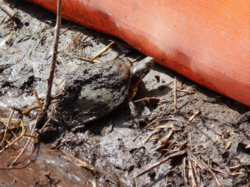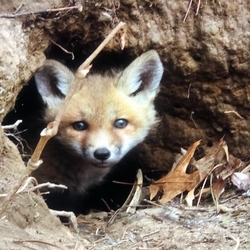Building an Energy Pipeline for the Future
A Better Way to Build
Proven approach protects wildlife, minimizes environmental impact during major natural gas construction projects
 Protecting the planet is one of our top priorities at Consumers Energy.
Protecting the planet is one of our top priorities at Consumers Energy.
That’s why we’re committed to caring for the environment as we replace hundreds of miles of the “expressway” powering our gas system as part of our Natural Gas Delivery Plan, a 10-year roadmap to improve safety, reliability and affordability for our 1.8 million customers while creating a cleaner energy future.
As you might imagine, we encounter a variety of wildlife during a major pipeline construction project. Consumers Energy is dedicated to the planet and our crews are doing whatever we can to protect our furry and amphibious friends.
Start to finish, you can count on us to do the right thing when it comes to safeguarding the land, water, wildlife and other natural resources we all cherish.
Before Construction
We complete a detailed environmental inventory of the project area — including all wetlands, drains and stream crossings — and are working with applicable federal, state and local agencies to consider all environmental concerns. This includes identifying and protecting any threatened or endangered species and their habitats.
During Construction
An environmental inspector is on site daily to ensure best practices and protect wildlife, and a herpetologist will help impacted reptiles such as snakes and turtles. During past projects, we’ve cared for sick foxes and rescued adult turtles and turtle eggs from the right-of-way, including those of the Blanding’s turtle, which is on Michigan’s “special concern” species list. The eggs were incubated under the care of a herpetologist, hatched and released back into their habitat. We use special fencing made of all-natural fiber to prevent erosion without trapping or harming birds, snakes or other animals. And we’ll use green construction techniques to conserve soil, reduce waste and recycle wood and other materials.
“It’s the culture we’ve created,” said environmental engineer Lindsey Johnson, who’s helped create a successful template for our major transmission pipeline projects. “It’s amazing to work for a company that’s so supportive of these efforts.”
The start of construction on the Mid-Michigan Pipeline project, a two-phase, $550 million effort to replace 55 miles of pipeline in five counties, was filled with activity to protect our furry and amphibious friends. In the first few months of work, we:
- Rescued more than 5,000 amphibians and reptiles, comprised of 25 species, have been recovered from the construction right-of-way or protected by environmentally friendly wildlife barrier fencing. This includes a clutch of snapping turtle eggs; a picture is below.
- Discovered a fox family on the right-of-way, including baby foxes, known as kits. We worked in other areas of the right of way for several weeks to allow the kits to leave the den and not be disturbed during construction.
- Spotted multiple whitetail deer fawns and bird nests that were avoided by construction crews and machinery.
After Completion
We’ll restore construction areas in an environmentally responsible manner. On past projects, we’ve used a special pollinator mix to restore wild and wetland areas where new pipeline was buried to create new habitat for butterflies, bees and other pollinators.
Stepping Lightly in Sensitive Areas
 Some project routes include natural areas, parks and trail systems. Construction on the Mid-Michigan Pipeline, for example, briefly passes through or near to the Waterloo State Recreation Area, the Pinckney Recreation Area, the Unadilla State Wildlife Area, the Mike Levine Lakelands Trail State Park, Sleepy Hollow State Park and the Chelsea to Stockbridge corridor of the Border-to-Border Trail managed by the Washtenaw County Parks and Recreation Commission.
Some project routes include natural areas, parks and trail systems. Construction on the Mid-Michigan Pipeline, for example, briefly passes through or near to the Waterloo State Recreation Area, the Pinckney Recreation Area, the Unadilla State Wildlife Area, the Mike Levine Lakelands Trail State Park, Sleepy Hollow State Park and the Chelsea to Stockbridge corridor of the Border-to-Border Trail managed by the Washtenaw County Parks and Recreation Commission.
We’re up to the challenge because we’re accustomed to working safely and carefully in unique environmental settings. The recent Saginaw Trail Pipeline project, for example, went through the Shiawassee National Wildlife Refuge in Saginaw County and Kensington Metropark in Livingston County. We worked closely with local officials to communicate with their constituencies, protect the environment and reduce our footprint.
Common sensitive area strategies include:
- Communicating clearly about plans with key stakeholders and landowners through a variety of channels, including signage and public open houses.
- Identifying and protecting sensitive species and their habitats.
- Safely relocating endangered species such as turtles, frogs and snakes from the construction path.
- Installing wash bays to clean vehicles and equipment entering construction areas to ensure no invasive species were introduced.
- Restoring habitat with native plants and trees as recommended.
On a Mission to Cut Methane
In addition to protecting natural resources, upgrading our natural gas transmission pipelines is part of our larger strategy to create a cleaner energy future for Michigan by reducing emissions of methane, a greenhouse gas 25 times more potent than carbon dioxide. We’ve set a goal to achieve net zero methane emissions by 2030. And replacing aging transmission pipes and infrastructure dating to the 1940s is a key piece of our plan. By reaching our net zero goal, we’ll reduce our methane emissions by more than 10,000 metric tons — that’s the equivalent of removing about 55,000 vehicles from the road for a year or preserving more than 300,000 acres of forest.